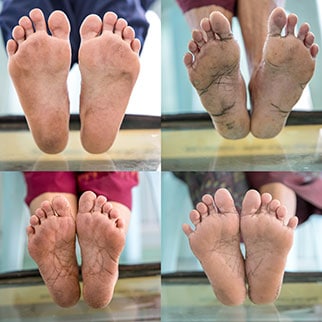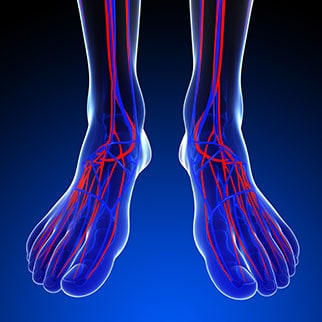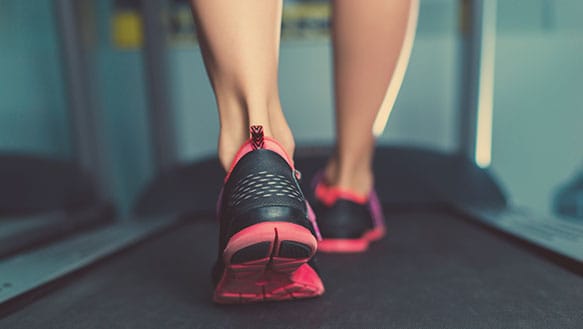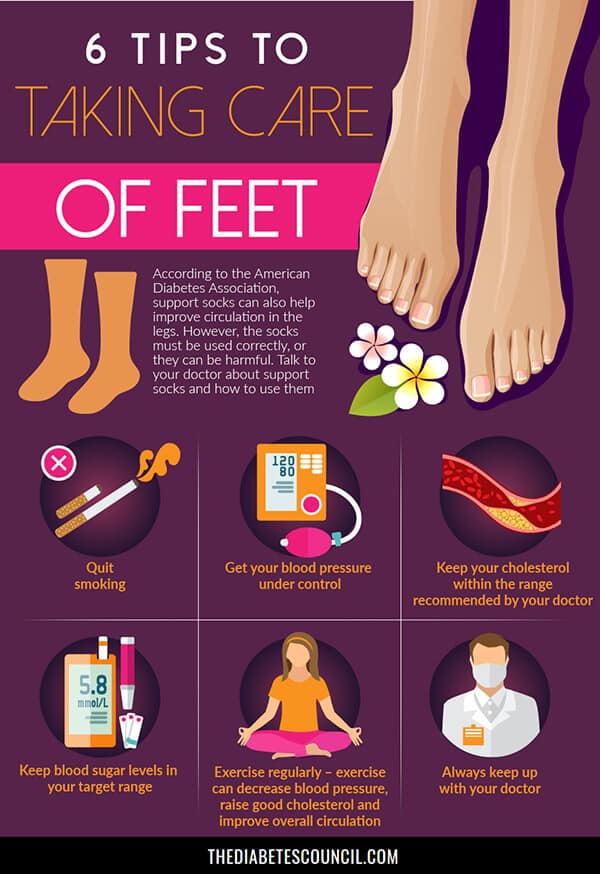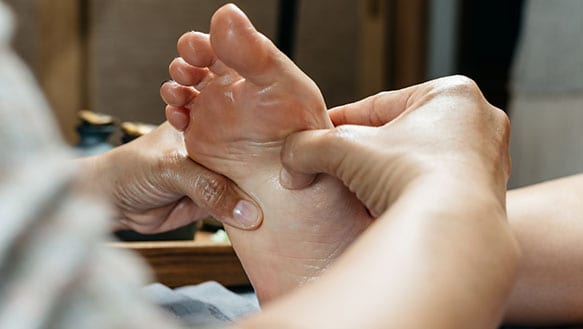
High blood sugars are responsible for poor blood circulation and neuropathy in a person with diabetes.
Injured nerves become lose sensitivity, and the person with diabetes becomes unaware when they’ve stepped on a sharp object. This is what we call “peripheral neuropathy.”
When damage to vessels is done with high blood sugars due to diabetes over time, we see the combination of decreased circulation and decreased sensation in the periphery (most commonly in the legs and feet). This can result in a number of problems for the person with diabetes.
The longer you have diabetes, the more likely you are to have problems with your nerve pathways related to your condition. The good news is you can increase your circulation if you have diabetes. Let’s talk about how you can accomplish that.
Contents
How can one tell if they have poor circulation?
If you’ve had high blood sugars over a long period of time, you lose the signals that are sent from nerve to nerve, thus your feeling in affected areas. Smaller blood vessels become weakened and depraved of needed oxygen and other nutrients. That’s why people with diabetes have a high rate of amputation. They will experience slower wound healing than people without diabetes, with increased risk of the infection turning to gangrene.
Neuropathy and poor circulation in extremities lead people with diabetes to ignore cuts and wounds until they become infected and are harder to treat. Blood vessels become thickened and the lumen narrows.
Not enough blood flow due to injury of vessels, no blood flow, and decreased sensation combine to increase risks for people in the diabetic population.
If you have diabetic neuropathy, you may feel…
- A pin and needles feeling or prickly feeling in your legs and feet
- Very cold or very hot temperature in feet
- Soreness or sensitivity
- Numbness
- No feeling of pain even with the presence of sores and cuts
- Injured feet feels has decreased pain level and discomfort (loss of protective sensation)
I recommend reading the following pieces:
Why is it important to increase foot circulation?
What happens if circulation is bad?
Once you already have circulation issues and peripheral neuropathy in your feet, what can be done? You know you are at increased risk for problems with your feet, but there are steps you can take to help with it.
Regular foot examinations by a health care provider are a must for appropriate diabetes foot care. The examination can be done by a podiatrist, or “foot doctor,” or your primary care physician.
There is a difference between a regular foot examination and a comprehensive one. In the comprehensive examination, the provider will use a 10 mm fishing line type filament to test sensation on different areas of your feet. They will ask you to close your eyes, and tell them where they touched you with the monofilament. You will indicate by referring to your toes or other parts as you deem right.
If there are any calloused areas, wounds or non-healing ulcers, or if you’ve ever had a non-healing ulcer, the provider will make a note of it. You may be asked questions about your overall foot care practices, and the examiner may provide some foot care practice demonstration or instruction to you.
You should follow all foot care recommendations. It’s good for a person diagnosed with diabetes, poor circulation and peripheral neuropathy to see a podiatrist once per year. If you have thickened toenails, it may require you to visit more often and have your nails clipped or special treatments.
At any rate, taking care of your feet when you have diabetes should be of paramount importance to you.
How can one improve circulation in feet?
Let’s discuss some natural and medical ways that you can improve the circulation in your feet and prevent foot ulcers that won’t heal and lead to amputation.
Keep blood pressure and cholesterol under control, as well as blood sugars and A1C. Keep all your doctor check ups and wear diabetic socks, checking your feet daily and reporting any injuries or anything you are concerned about.
Certain medications can be given to improve circulation, such as blood thinners such as warfarin (coumadin), but they don’t stop the processes that lead to disease which is plaque build-up in arteries and narrowing vessels.
Angioplasty is one medical treatment that can treat arteries when they become narrowed or blocked from blood flowing freely. A catheter is placed in the artery and a balloon is used to unblock the problem area in the artery.
In worse cases, a stent may be placed in the blocked artery and left to keep blood flowing.
Coronary bypass surgery can improve leg circulation if the blockage is not too severe. The use of bypass grafts which can be made from a vein harvested from the patient’s own body can be used to try to improve blood flow to the extremities.
Exercises that help with circulation
Exercise is a great way to get the blood pumping and thus improving circulation to your feet. You will want to do a cardiovascular exercise that gets your heart rate up such as biking, walking, running, swimming or taking an exercise aerobics class.
Walking is a great exercise that most people can do with no problems. It’s great for poor circulation because you are moving your feet, toes, legs and ankles which improves circulation to the area.
8 Tips to taking care of feet
- Support socks can also help improve circulation in the legs only if worn correctly, otherwise they can be harmful. Your doctor should provide you with information how to properly use them
- Quit smoking – this is the number one thing that you can do to improve your circulation if you have diabetes (arteries harden when you smoke)
- Get your blood pressure under control – if it’s not under control, see your doctor and take steps to get it in range to improve circulation (high blood pressure stunts circulation, narrows and hardens arteries)
- Keep your cholesterol within the range recommended by your doctor – find out what your numbers are. Make sure you have the right amounts of good cholesterol, bad cholesterol, triglycerides and total cholesterol – work with a Registered Dietitian to get cholesterol in range if they are not there (many people with diabetes have a dyslipidemia)
- Keep blood sugar levels in your target range – if you’re not sure what they are ask, your doctor or Certified Diabetes Educator about measures to improve your numbers
- Exercise regularly – exercise can decrease blood pressure, raise good cholesterol and improve overall circulation – try performing 30 minutes of aerobic or cardiovascular activity such as walking or biking five days per week
- Always keep up with your doctor check ups and see a podiatrist once per year or more often if needed when you have diabetes
- Use socks that help with circulation – support socks are recommended by the American Diabetes Association. You can learn all about Diabetic Socks here.
- Inspect your feet daily
- Don’t walk anywhere barefoot to avoid infections, scabs, etc 1
Further reading:
- Pre-existing Diabetes And Pregnancy
- Blurred Vision – An Important Sign of Diabetes
- Will Type 2 Diabetes Affect My Memory?
- Couples with Diabetes: What You Need To Know
- 13 Amazing Management Tips for Adults Living with Type 2 Diabetes
- Why You Should Be Concerned With Pain And Numbness When You Have Diabetes
FAQs
Who can diagnose that I have poor circulation?
A doctor or podiatrist can diagnose you and determine if you have poor circulation or peripheral neuropathies that place you at increased risk for nonhealing ulcers and other problems related to poor circulation.
Are there foods that can especially help with circulation?
There are a number of foods that you can eat that help to improve your circulation.
- Foods rich in Vitamin C, such as oranges, naturally thin your blood and help it to pass more freely though blood vessels.
- Flavonoids are often mentioned when improving circulation. It’s good to know that dark chocolate has these flavonoids. Pick varieties that are 70% cocoa or better.
- Cayenne pepper is known to tighten and increase the elasticity of blood vessels as well as increase metabolism.
- Sunflower seeds have Vitamin E in them which can also help prevent blood from clotting and help thickened, sticky blood get through vessels.
- Ginger is known for its increased circulation properties, and garlic helps keep plaque from building up in arteries and has a cleansing effect.
- High in necessary fiber, “Goji” berries also increase immune system response and increase circulation.
- Watermelon has the antioxidant lycopene, which is also thought to improve circulation.
- Another great food to eat is salmon. It’s a fatty fish that has increased levels of Omega 3 Fatty Acids, which have been proven to help your heart and circulatory system.
- Avocado is another good food to add to your grocery list, as it’s high in Omega 3s, too.
Should I get massages, focuses on feet, regularly? Will it help?
Massaging the foot area can help to open circulation. Daily massaging of your own feet may work to help increase circulation. You could also go for a professional massage if you so choose.
To massage your feet, lay down on the couch or bed and place your feet up on pillows or at a 45-degree angle above your heart level. This will also help to improve blood flow to the area.
For Beurger’s exercises, raise them for 10 minutes, lay them flat on the bed for 10 minutes, then hand them off the side of the bed for 10 minutes. After performing Beurger’s exercises, it is a good time to begin to massage your lower legs, ankles, feet and toes. Work your way from the middle to the end of your toes.
While standing, press your toes down and your heels up toward the sky. Move your heel down and rotate your toes toward the sky. This is another great exercise to improve foot circulation.
You may be surprised at how much these exercises improve your circulation to your legs and feet.
Are there side effects to the medications that can help with circulation of blood?
Many treatments are available to relieve the pain and discomfort of peripheral arterial disease (PAD) and neuropathy. Drug treatment is often the first one offered. For PAD, pain relievers, blood thinners, and other drugs that improve blood flow may be prescribed. Drugs prescribed for peripheral neuropathy include pain relievers, certain antidepressants and anticonvulsants, and, as a last resort, narcotics. However, many medicines have side effects and may not be tolerated.
For neuropathy, there are also ointments for topical use and therapies such as transcutaneous electrical nerve stimulation (TENS), which uses electricity to block pain signals, and monochromatic infrared energy therapy, which uses near-infrared energy to increase blood flow and relieve pain. Vascular surgeries such as angioplasty or bypass may be used to treat severe PAD, and surgery to relieve nerve compression can help certain types of neuropathy.
What are the effects of relaxation on feet and circulation?
If your feet are always sensitive and painful to touch, increasing the time you relax can help improve your circulation. By relaxing, we mean relaxation exercises, such as “Warm Feet” exercises.
It uses both relaxation techniques and biofeedback as a method.
Is Biofeedback assisted relaxation technique better than all treatments?
I’m not sure if it’s better than all treatments, but biofeedback and relaxation techniques have their advantages. They are inexpensive and they provide a therapy that can compliment other therapies for poor circulation and neuropathies.
Both the mind and body are used in this technique called “Warm Feet.” It helps to lower blood pressure and improve coping through relaxation in people with diabetes in addition to its circulation improving properties.
You may be wondering how does relaxation help with circulation? Here is the basic premise of it.
When under duress, our body goes through the autonomic response of fight or flight as our sympathetic system kicks in. Herein our heart rate raises, blood pressure increases, and blood sugar levels increase. Blood flow is sped up to the brain and the heart, and to all your muscles.
When we relax, we reverse this situation, and everything slows down. When you get home from work and finally can put your feet up, you feel the tension leave your muscles, and you begin to breath slowly and deeply. As your mind relaxes, your body slows along with your blood pressure and heart rate. This is provoked by activity from the parasympathetic system.
During relaxation, increased oxygen and nutrients are sent to the heart and brain. That’s why relaxation is good for the circulation in our legs and feet. Skin becomes pinker and warmer.
What is the “Warm Feet” technique?
To help you learn in using the body’s natural response during relaxation, try the Warm Feet technique. It’s supposed to improve blood flow in your arms, hands, legs and feet.
An audiotape guides you through releasing tensions from muscles along with deep breathing techniques. You then go into the visualization phase, where you think about your feet being warm and comfortable. The mind takes over and the feet begin to feel warmer just from the thought of it.
A third part of Warm Feet is the biofeedback. In this, the skin temperature is measured before and after the technique is performed. Skin temperature increase is the goal with this technique, which through research at the University of Wisconsin was tested. In the trial, people with chronic ulcers that wouldn’t heal tried the relaxation techniques with biofeedback.
It was significant because the participants experienced increased healing of wounds and sensations in extremities. For some reason, mind over matter seems to work in these cases, so relaxation and biofeedback shouldn’t be overlooked as essential treatments.
Find a health care provider experienced in Warm Feet to get started. You may find these in Diabetic Wound Care Centers or in other centers where diabetes education is offered of wound care and healing is provided. Generally, Warm Feet takes about 45 minutes to perform and it takes awhile to master the art of relaxation.
Once you are experienced with Warm Feet, you should see increased healing of wounds and increased circulation over all with skin temperatures that show an increase anywhere from 4 to 10 degrees Fahrenheit.
What can the Warm Feet technique do for you?
Warm feet can…
- Increase blood flow to your arms and legs
- Decrease pain felt in your arms, legs and feet
- Help you to heal foot ulcers faster
- Decrease stress and increase coping 2
Can poor circulation lead to possible amputation?
Yes, poor circulation can lead to increased risk of amputation in people with diabetes. Once amputation has occurred, life expectancy is just five years.
What are some of the complications of poor circulation, if not treated properly?
Peripheral Arterial Disease (PAD) is one complication that accounts for the cause of poor circulation and neuropathies in the extremities. Both are caused in the long run by high blood sugars, but are still two very different conditions.
In PAD, plague is deposited on the lumen of the blood vessel and causes it to become hardened and narrower. Look for leg cramping pains as signals which can occur during activities and stop with rest. Other symptoms include numbness, cold temperature of extremities, pins and needles in the legs and feet and problems with wounds not healing properly.
Diabetic peripheral neuropathy is another common complication that can affect the arms, hands, legs and feet. The resulting loss of feeling is due to high blood sugars over time. Symptoms include wounds that are slow in healing, balance problems, problems with gait, deformities of feet and increased pain and burning or loss of protective sensation.
My work requires a lot of sitting. Can I do something about that?
Try working elevated. You can purchase desks that allow you to stand. Get up and walk around when you’re on the phone, or at least every thirty minutes. Try chair exercises or sit on a therapy ball while you work which helps work on core muscles for posture. There are many ways you can work activity into a sedentary lifestyle.
I have diabetes and my feet are constantly swollen. Does it mean I have poor circulation?
You should see a doctor to determine why your feet are swollen. Often times, congestive heart failure can also result in swollen feet when excess fluid is retained and cause a condition known as “edema.” It’s important for your doctor to evaluate the cause of any swelling you may have. 3
Over to you
Let us know what you think about our article related to your feet and circulation with diabetes. Did you learn anything new? Let us know what you thought and how you work to improve your circulation in the comments box below.
TheDiabetesCouncil Article | Reviewed by Dr. Jack Isler MD on August 23, 2018


